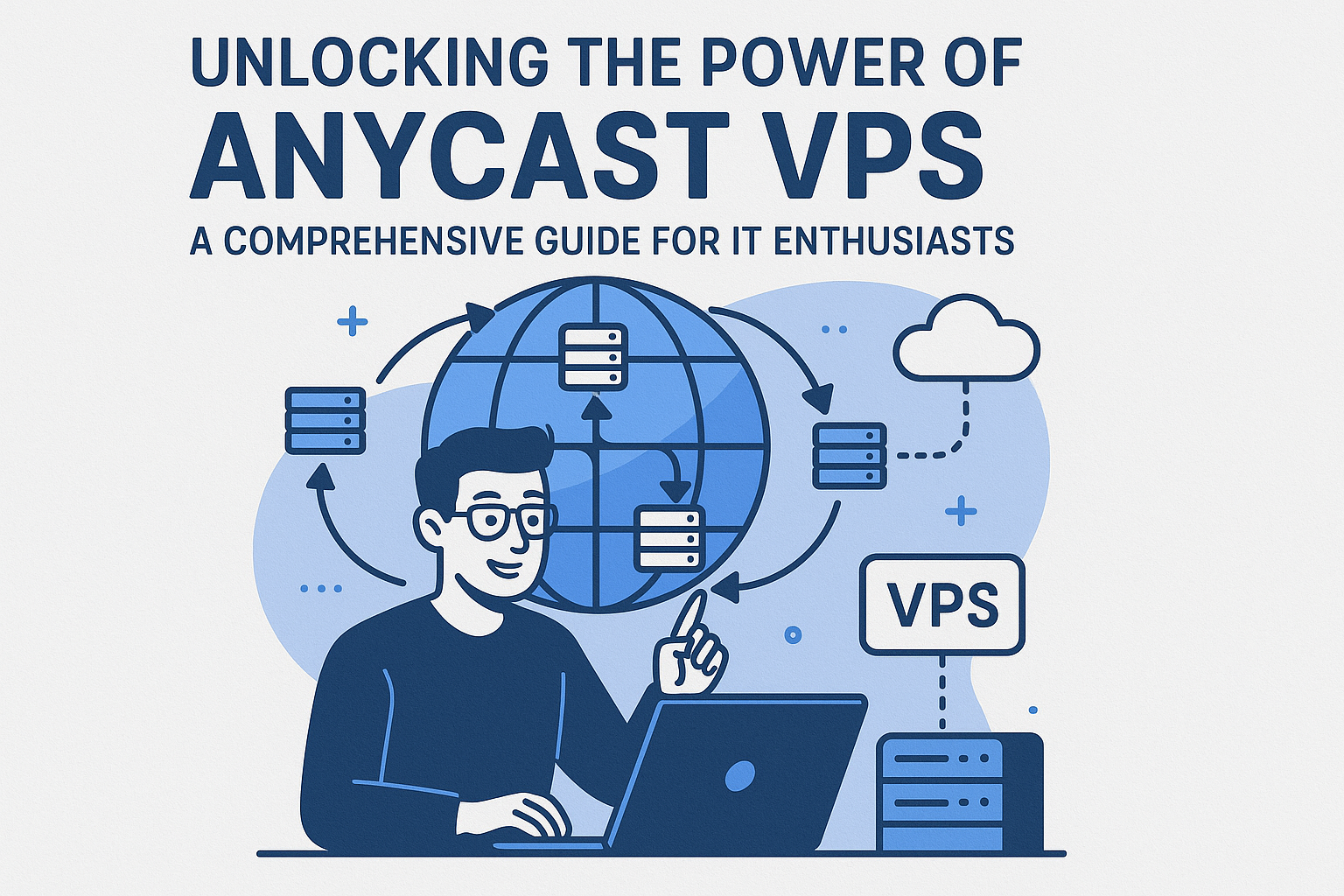Unlocking the Power of Anycast VPS: A Comprehensive Guide for IT Enthusiasts

In the ever-evolving landscape of IT infrastructure, the demand for faster, more reliable, and geographically distributed services has never been higher. Enter Anycast VPS—a technology that promises to revolutionize how we approach virtual private servers (VPS) by leveraging the power of Anycast routing. If you’re an IT professional, blogger, or enthusiast looking to understand how Anycast can enhance your VPS setup, this post is for you. We’ll dive deep into what Anycast VPS is, how it works, its benefits, challenges, and real-world applications. By the end, you’ll have a clear understanding of why Anycast is becoming a game-changer in the world of virtual servers.
What is Anycast?
Before we delve into Anycast VPS, let’s first understand what Anycast is. Anycast is a network addressing and routing methodology where a single IP address is shared by multiple servers located in different geographical locations. When a user sends a request to an Anycast IP, the network automatically routes the request to the nearest server based on the routing protocol’s decision, typically Border Gateway Protocol (BGP). This “nearest” server is usually the one with the lowest latency or fewest network hops, ensuring faster response times and improved reliability.
Historically, Anycast has been used by large organizations for critical services like DNS (Domain Name System) resolution, where speed and uptime are paramount. For example, DNS root servers use Anycast to distribute queries across the globe, ensuring that users are always directed to the closest available server. However, with advancements in cloud computing and VPS technology, Anycast is now accessible to a broader audience, including small businesses and individual developers.
What is Anycast VPS?
An Anycast VPS is a virtual private server that utilizes Anycast routing to distribute incoming traffic across multiple VPS instances located in different data centers. Unlike traditional VPS setups, where each server has a unique IP address, an Anycast VPS shares the same IP address across multiple locations. This means that when a user connects to your VPS, they are automatically routed to the nearest available server, reducing latency and improving performance.
For instance, if you have Anycast VPS instances in Europe, the United States, and Asia, a user from Germany would be routed to the European server, while a user from Japan would connect to the Asian server—all under the same IP address. This setup not only enhances user experience but also provides built-in redundancy. If one server goes down, traffic is automatically rerouted to the next closest server without any manual intervention.
How Does Anycast VPS Work?
To understand how Anycast VPS works, let’s break it down into a few key components:
- IP Address Sharing: Multiple VPS instances in different locations are assigned the same IP address.
- BGP Routing: BGP is used to announce the same IP prefix from multiple locations. BGP determines the optimal path for data packets based on network topology.
- Traffic Routing: When a user sends a request to the Anycast IP, the internet’s routing infrastructure directs the request to the nearest VPS instance based on BGP metrics.
- Failover and Redundancy: If a particular VPS instance becomes unavailable, BGP withdraws the route for that location, and traffic is automatically rerouted to the next nearest instance.
This process is seamless and happens at the network level, meaning users don’t need to change anything on their end. The magic of Anycast lies in its ability to make distributed systems appear as a single, unified service.
Benefits of Anycast VPS
Now that we understand what Anycast VPS is and how it works, let’s explore the key benefits that make it an attractive option for IT professionals and businesses.
- Reduced Latency: By routing users to the nearest server, Anycast significantly reduces the time it takes for data to travel between the user and the server. This is crucial for latency-sensitive applications like online gaming, video streaming, and real-time communications.
- Improved Reliability and Uptime: Anycast provides built-in redundancy. If one server fails or experiences issues, traffic is automatically redirected to another server in the network, ensuring your services remain available even during outages or maintenance.
- Scalability: As your user base grows, you can easily add more VPS instances in new locations without changing your IP address, making scaling straightforward and cost-effective.
- Enhanced Security: Anycast can help mitigate Distributed Denial of Service (DDoS) attacks. By distributing traffic across multiple servers, it becomes harder for attackers to overwhelm a single point of failure. Some providers even offer DDoS protection as an add-on for Anycast IPs.
- Simplified Management: With Anycast, you don’t need to manage complex load balancers or DNS configurations to route users to the nearest server—the network handles it automatically, reducing operational overhead.
Challenges and Limitations of Anycast VPS
While Anycast VPS offers numerous benefits, it’s not without its challenges. Here are some key limitations and considerations:
- Session Persistence: Since Anycast routes traffic based on network topology, there’s no guarantee that a user’s subsequent requests will go to the same server. This can be problematic for applications requiring session persistence, like e-commerce sites or logged-in user sessions. To mitigate this, you may need to implement session sharing or use sticky sessions, adding complexity.
- Configuration Complexity: Setting up an Anycast VPS requires a good understanding of BGP and routing protocols. While some providers offer managed Anycast services, others may require you to handle the configuration yourself, which can be daunting for beginners.
- Cost: Implementing Anycast typically requires VPS instances in multiple locations, increasing costs. However, some providers offer affordable plans, making it accessible for smaller projects.
- Limited Provider Support: Not all VPS providers support Anycast out of the box. You’ll need to choose a provider that either offers managed Anycast services or allows you to set up BGP sessions.
- Potential for Suboptimal Routing: In some cases, the “nearest” server might not always be the best in terms of performance due to network congestion or other factors. Fine-tuning BGP settings or using additional tools may be necessary to optimize routing.
Real-World Applications of Anycast VPS
Anycast VPS is not just a theoretical concept—it has practical applications across various industries. Here are some examples:
- Content Delivery Networks (CDNs): CDNs use Anycast to distribute content closer to users, reducing latency and improving load times. By caching content on multiple Anycast VPS instances, CDNs serve static assets like images, videos, and scripts from the nearest server.
- DNS Services: DNS is a common use case for Anycast. By distributing DNS queries across multiple servers, providers ensure fast and reliable domain resolution.
- Load Balancing: Anycast acts as a natural load balancer by distributing incoming traffic across multiple servers, ideal for high-traffic websites or applications.
- Gaming and Real-Time Applications: Online games and real-time communication platforms benefit from Anycast’s low latency, reducing lag and enhancing user experience.
- IoT and Edge Computing: Anycast VPS can process data closer to IoT devices, minimizing latency and reducing the need to send data to a central server.
Setting Up Anycast VPS: A Step-by-Step Overview
If you’re interested in setting up your own Anycast VPS, here’s a high-level overview of the steps involved:
- Choose a Provider: Select a VPS provider that supports Anycast or allows BGP sessions (e.g., BuyVM, Vultr, or NetActuate).
- Acquire IP Space: You’ll need an IP address or prefix that can be announced from multiple locations. Some providers offer shared Anycast IPs, while others require you to bring your own.
- Set Up VPS Instances: Deploy VPS instances in multiple geographical locations for better coverage and redundancy.
- Configure BGP: Set up BGP sessions on each VPS to announce the Anycast IP, typically using routing software like BIRD or Quagga.
- Synchronize Data: Ensure all VPS instances are synchronized and serve the same content or services, possibly using a backend database or distributed file system.
- Test and Monitor: Test your setup to ensure traffic is routed correctly and failover works as expected, using monitoring tools to track performance.
While this is a simplified overview, actual implementation can vary based on your use case and provider.
The Future of Anycast VPS
As the demand for global, high-performance services grows, Anycast VPS is poised to play a significant role in IT infrastructure. Here are some trends and predictions:
- Increased Adoption: More VPS providers will likely offer managed Anycast services, simplifying implementation for businesses.
- Edge Computing Integration: Anycast will enable











